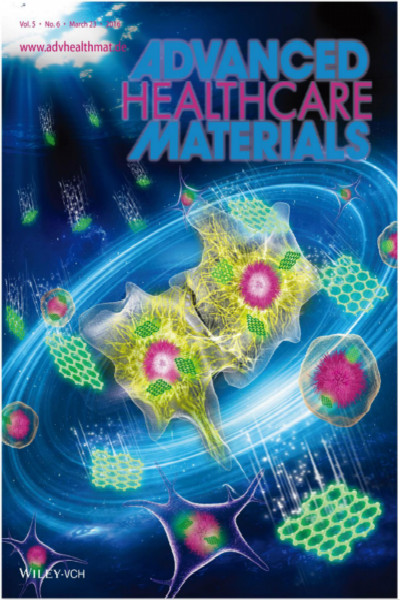Recently, Prof. Liu Hong’s group from State Key Laboratory of Crystal Materials has made several achievements in the study of nanostructure regulated stem cell differentiation. Three related research results were reported inSmall(published online:9 Feb 2016, 10.1002/smll. 201503946),Nanoscale(2016, 8, 7416–7422),Advanced Healthcare Materials(2016, 5, 702-710), respectively. Among them, a paper entitledEffects of Graphene Quantum Dots on the Self-Renewal and Differentiation of Mesenchymal Stem Cellswas published on the latest issue ofAdvanced Healthcare Materials as the cover story.

Regulation stem cell differentiation induced by physical property of nanostructured biomaterials and physical signal mediated by nanostructures is a new research topic in the field of interaction between stem cell and biomaterial, which plays an important role in tissue engineering and regenerative medicine. Actually, in vivo cells and tissues will encounter different structures and features, ranging from nanoscale to microscale, which have important influence on the morphology and function of cells or tissues. Previous studies on biomaterials have shown that surface nanomaterials or nanostructure can influence the migration, proliferation and differentiation of stem cells. TiO2 nanorod array on surface of implantable biomaterials designed and synthesized by Prof. Liu’s group facilitates stem cell differentiation into osteoblasts, which improves the osteoinductivity of implant. More importantly, patterned TiO2 nanorod arrays on the smooth TiO2 ceramic are constructed by a combination of microfabrication and a chemical synthesis process, which realizes the location-committed osteogenic differentiation of MSCs. These results would have promising applications in engineering implant materials for multi-cell construction, which is urgent to be saluted in tissue engineering.
Furthermore, Prof. Liu’s group realized the bio-labeling of MSCs using the second harmonic generation effect of LiNbO3 nanocrystal and fluorescent property of graphene quantum dots respectively under confocal laser scanning microscopy. In addition, they evaluated the effect of LiNbO3 nanocrystal and graphene quantum dots on the stem cell differentiation after uptake by MSCs, and found that both nanoparticles could enhance osteogenic differentiation of MSCs, which is of great importance to the bio-applications of LiNbO3 nanocrystals and graphene quantum dots.
The above research was supported by Natural Science Foundation of China, Fundamental Research Funds of Shandong University and State Key Laboratory of Crystal Materials, Shandong University.
Related articles
http://onlinelibrary.wiley.com/doi/10.1002/smll.201503946/abstract
http://pubs.rsc.org/en/content/articlelanding/2016/nr/c6nr00785f#!divAbstract
http://onlinelibrary.wiley.com/doi/10.1002/adhm.201500770/abstract
http://onlinelibrary.wiley.com/doi/10.1002/adhm.201670026/abstract
Translated by Qiu Jichuan, Sang Yuanhua, Michelle Pu
Edited by Pu Yang
Source: view.sdu.edu.cn